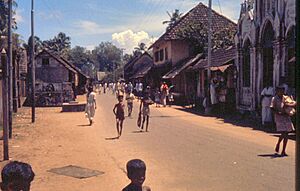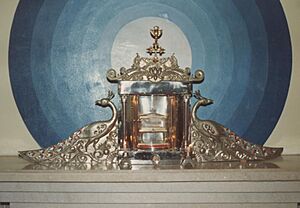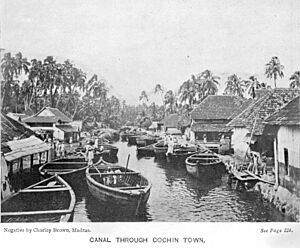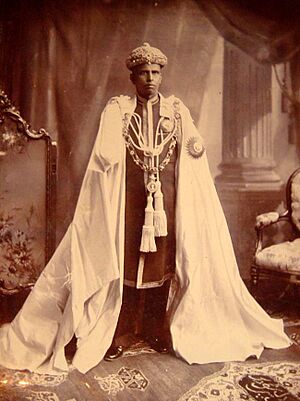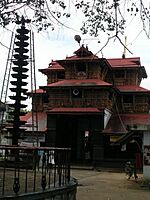Kingdom of Cochin facts for kids
Quick facts for kids
Kingdom of Cochin
Kochi Rajyam
|
|||||||||
|---|---|---|---|---|---|---|---|---|---|
| 12th century CE–1949 | |||||||||
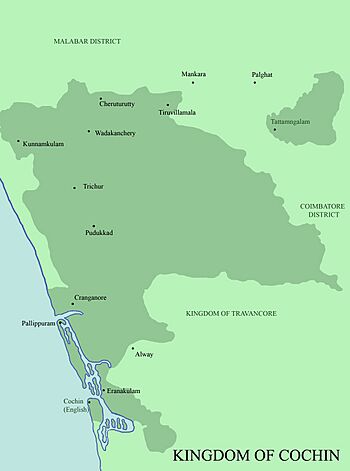 |
|||||||||
| Status |
|
||||||||
| Capital | Perumpadappu Ponnani Kodungallur Thripunithura Thrissur Mattancherry |
||||||||
| Common languages | Malayalam | ||||||||
| Religion | Majority: Hinduism (official) Minority: Christianity Judaism Islam |
||||||||
| Government | Absolute monarchy Princely state |
||||||||
| Raja | |||||||||
|
• 12th century CE (first)
|
Veera Kerala Varma | ||||||||
|
• 1948–1949 (last)
|
Rama Varma XVIII | ||||||||
| Diwan | |||||||||
|
• 1812–1818 (first)
|
John Munro | ||||||||
|
• 1944–1947 (last)
|
C. P. Karunakara Menon | ||||||||
| History | |||||||||
|
• Established
|
12th century CE | ||||||||
|
• Disestablished
|
1949 | ||||||||
| GDP (PPP) | estimate | ||||||||
|
• Total
|
600.03 crores USD | ||||||||
| Currency | Rupee and Other Local Currencies | ||||||||
|
|||||||||
| Today part of | India | ||||||||
The Kingdom of Cochin, also known as the Kingdom of Kochi, was an old Hindu kingdom in the central part of what is now Kerala state in India. It started around the 12th century and lasted until 1949. That's when it joined the new country of India. The kingdom was named after its capital city, Kochi (Cochin).
Historically, the capital of Cochin was in Kodungallur. But in 1341, a big flood caused problems. So, the capital was moved to Cochin. By the early 1400s, Cochin found it hard to defend itself. By the late 1400s, the kingdom became much smaller. This happened because of attacks from the Zamorin of Calicut.
When Portuguese ships arrived in India, the Kingdom of Cochin was struggling. It had lost many of its smaller areas to the Zamorins. Cochin wanted to stay independent, so its king, Unni Goda Varma, welcomed Pedro Álvares Cabral in 1500. They made a deal to work together against the Zamorin of Calicut. The Portuguese built forts, like Fort Manuel. Cochin became a Portuguese protectorate from 1503 to 1663. This meant Portugal helped protect Cochin from other powers.
After a war between the Portuguese and the Dutch, the Dutch East India Company became Cochin's ally (1663–1795). Later, the British East India Company took over in 1795. This made Cochin a Princely State under the British Empire.
In 1950, the Kingdom of Travancore joined with the Kingdom of Cochin. They formed the state of Travancore-Cochin. Later, in 1956, some areas were moved to Madras State. The parts of Travancore-Cochin where people spoke Malayalam joined with other Malayalam-speaking areas. This created the modern state of Kerala on November 1, 1956. This was part of the States Reorganisation Act, 1956.
The Kingdom of Cochin was first known as Perumpadappu Swarupam. It was part of the Later Chera kingdom. After the Chera dynasty fell in the 12th century, Perumpadappu Swarupam became independent. It became politically important only after the Portuguese arrived. The rulers of Perumpadappu had family ties with the rulers of Edappally. When Kochi and Vypin were given to the Perumpadappu rulers, they became known as the kings of Kochi.
Contents
Territories of the Kingdom
From 1800 to 1947, the Kingdom of Cochin covered a large area. This included most of today's Thrissur district. It also had parts of Palakkad district and Ernakulam district. These areas are now part of Kerala.
History of Cochin
How the Kingdom Started
There are no old written records about how the Kingdom of Cochin began. We also don't have clear records about the Cochin royal family. What we know comes from old folk tales and stories. These stories give us a general idea of how the ruling family started.
Old writings like Keralolpathi and Perumpadapu Grandavari are mostly myths. They are not always reliable historical sources.
One story says that the last ruler, Cheraman Perumal, divided his land. He gave parts of it to his nephews and sons. Thirty-four small kingdoms were given to a princess. These kingdoms stretched from Kanyakumari to Gokarna.
Historians believe this division might have happened around the 12th century. This was during the time of the Second Chera Kingdom.
Early Years of the Kingdom
The first main base of the kingdom was at Perumpadappu. This was near Ponnani in today's Malappuram district. The ruler of Perumpadappu moved to Kodungallur (Cranganore) when the Zamorin of Calicut took over the Ponnani region. This happened after a war called the Tirunavaya war.
The Zamorin of Calicut conquered the Porlathiri kingdom. Then, he took parts of the Perumpadappu kingdom. He tried to control it completely.
Even though they lost their northern lands, the Perumpadappu family kept a large kingdom. It covered a wide area in central Kerala. Their land stretched from Pukkaitha in the north to Aanamala in the east. It also went down to Purakkad in the south.
Royal Family and Succession
The Perumpadappu family eventually had five main branches. Each branch had its own home and soldiers. But all five branches came together under one king. The king was the oldest male member from all five branches.
The Cochin royal family followed a system called matrilineal succession. This was common in Kerala. It meant that the next ruler was not the king's son. Instead, it was his brother or his sister's son (his nephew). The oldest male was usually chosen. Later, this rule became more flexible. Kingship sometimes became elective. This made sure the ruler was not too old or unable to lead.
Kings often retired when they got old or couldn't fight anymore. They would then live a religious life. Power would pass to the next ruler.
This system sometimes caused arguments among the five branches. The Zamorin of Calicut used these family quarrels to gain more power. He would sometimes act as a judge, which helped him increase his influence.
Moving to Cochin
The city of Cochin started as a small village. In 1341, big floods from the Periyar River changed the land. A new opening formed between the Vembanad lagoon and the Arabian Sea. This created the Cochin peninsula and Vypin island.
The old port of Cranganore started to fill with sand. So, trade moved to the new opening at Cochin. Merchants began to move there and build businesses. The old city of Kodungallur declined. The new port city of Kochi grew in wealth. The first part of the city grew in Mattancherry.
The land where Cochin city later grew belonged to the royal family of Edapalli. In the early 1400s, the king of Edapalli married a sister from a Perumpadappu branch. Their son was an heir to both families. But he was not the first in line to rule Perumpadappu.
The King of Edapalli gave some land to his prince son. This land included southern Vypin island and northern Karapuram. It was meant to be a training area for the prince. He was called "Kocchu Thampuran" (junior lord). So, this area became known as "Kochi/Cochin." At first, the "kingdom of Cochin" was a small part of Edapalli. It was separate from the larger Perumpadappu state.
Cochin grew wealthy, giving the junior prince more power. He eventually became king over his older relatives. He also separated Cochin from Edapalli.
Because of this, the large "Kingdom of Perumpadappu" became known as the "Kingdom of Cochin." The capital moved from Kodungallur to Vypin in Kochi. New rules were made. Succession was limited to the Cochin branch of the family.
Alliance with Ming China (1411–1433)
The port at Kozhikode (Calicut) was very important for trade in the Middle Ages. But Cochin was becoming a strong rival. So, the Ming dynasty of China decided to help Cochin. They gave special status to Cochin and its ruler, called Keyili by the Chinese.
Admiral Zheng He was sent to Cochin. He brought a stone tablet with a message from the Yongle Emperor. As long as Cochin was protected by Ming China, the Zamorin of Calicut could not attack it. This helped avoid a war. When the Ming voyages stopped, the Zamorin of Calicut invaded Cochin. By the late 1400s, the Zamorin took over Cochin. He put his own ruler in charge.
Becoming a Vassal of Calicut
The new king of Cochin had conflicts with his relatives. These relatives wanted to regain their power and land. This led to the Zamorin of Calicut getting involved. The Zamorin attacked Cochin. His armies won and forced Cochin to agree to a settlement. The king of Cochin had to promise to be a vassal to Calicut. This meant Cochin needed the Zamorin's approval for new rulers. It also had to pay yearly tribute and send soldiers to the Zamorin's wars.
This was the situation when the Portuguese arrived in 1500. The Kingdom of Cochin was partly controlled by the Zamorin. The king of Cochin, Unni Goda Varda, wanted to break free. He saw an alliance with the Portuguese as a way to overthrow the Zamorin. He hoped to regain Cochin's independence.
Alliance with Portugal (1500–1663)
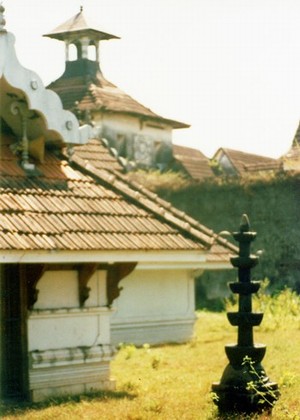
The Portuguese arrived in Kappad, Kozhikode in 1498. This opened a direct sea route from Europe to India. Cochin became the site of the first European settlement in India. In 1500, Portuguese Admiral Pedro Álvares Cabral landed in Cochin. He came after being turned away from Calicut. The Raja of Cochin welcomed the Portuguese. They signed a friendship treaty. The raja let them build a trading post in Cochin.
The raja then declared war on the Zamorin of Calicut. In 1502, Vasco da Gama arrived in Cochin. Their friendship was renewed. Vasco da Gama later attacked Calicut. This angered the Zamorin. He attacked Cochin after Vasco da Gama left. The Portuguese trading post was destroyed. The raja of Cochin and his Portuguese allies had to retreat to Vypin Island. But more Portuguese ships arrived. The Zamorin's army left the siege.
After helping the Raja of Cochin, the Portuguese got permission to build a fort. This was Fort Emmanuel in Fort Kochi. It was built to protect their trading post from Calicut's attacks. The fort was first made of timber in 1503. The local raja helped with workers and materials. In 1505, a stone fort replaced the wooden one. Another fort, "Castelo de Cima", was built on Vypeen Island for better defense.
The ruler of the Kingdom of Tanur joined the Portuguese against the Zamorin. This made the Kingdom of Tanur one of the first Portuguese colonies in India. Many members of the Cochin royal family in the 1500s and 1600s came from Tanur.
The raja of Cochin continued to rule with Portuguese help. The Portuguese slowly increased their weapons in Cochin. This was supposedly to help the king protect Cochin. For a long time, Cochin was a very important Portuguese base in India. They exported many spices, especially pepper, from there.
In 1530, Saint Francis Xavier arrived. He started a Latin Christian mission. Cochin was also where Vasco da Gama was buried. His remains were later moved back to Portugal in 1539. After Afonso de Albuquerque, Portuguese influence in Kerala began to decline.
Alliance with the Dutch (1663–1766)
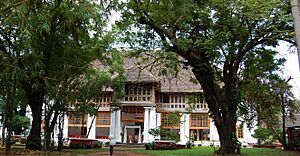
After the Portuguese, the Dutch became allies with Cochin. The Dutch had conquered Quilon. Some unhappy members of the Cochin Royal family asked the Dutch for help. They wanted to overthrow the Cochin Raja. The Dutch landed at Njarakal. They captured the fort at Pallippuram. They then gave it to the Zamorin.
Mysorean Invasion (1766–1799)
The ruler of Mysore, Hyder Ali, conquered Cochin. In 1763, he conquered Bednur. The Ali Rajah of Cannanore asked Hyder Ali to invade Kerala. He wanted help against the Zamorin of Calicut. The Muslim leader of Cannanore was an old rival of the powerful Kolathiri. He actively helped Mysore during the invasion.
Ali Raja captured and burned the Kolathiri Raja's palace. The Kolathiri Raja escaped to Tellicherry, which was a British settlement. After winning, Ali entered the Kingdom of Kottayam. He occupied it with help from local Muslims.
After a bloody battle, Ali took Calicut. He then marched towards Coimbatore. Mysore appointed a Raja as military governor. A former officer named Madonna became the civil governor of Malabar.
British Princely State (1814–1947)
In 1814, the Anglo-Dutch Treaty was signed. The islands of Kochi, including Fort Kochi, were given to the United Kingdom. This was in exchange for the island of Banca. Even before this treaty, English people lived in Kochi. During the British Raj, the Princely State of Cochin was surrounded by British Malabar District. It was bordered by British land on three sides. Travancore was to the south.
By the early 1900s, trade at the port grew a lot. The king wanted to make the port even better. So, he brought a harbor engineer named Robert Bristow to Cochin in 1920. He got help from Lord Willingdon. Over 21 years, Bristow helped the king. They made Cochin the safest harbor in South Asia. Ships could dock right next to the new inner harbor.
Meanwhile, Fort Cochin became a municipality in 1866. This was part of a British Indian law. The Maharajah of Cochin started local administration in 1896. He formed town councils in Mattancherry and Ernakulam. In 1925, a Kochi legislative assembly was created. This allowed the public to take part in governing. The assembly had 45 members. Ten of them were chosen by the government. Thottakkattu Madhaviamma was the first woman to be a member of any legislature in India.
Cochin was the first princely state to willingly join the new Dominion of India in 1947. India became a republic on January 26, 1950. Travancore merged with Cochin to form Travancore-Cochin. This state then joined with the Malabar district of Madras Presidency. On November 1, 1956, the Indian state of Kerala was formed.
Administration of Cochin
For administrative purposes, Cochin was divided into seven areas called taluks. This was from 1860 to 1905 AD. These taluks included Chittur, Cochin, Cranganore, Kanayannur, Mukundapuram, Talapalli, and Trichur.
| Taluk | Headquarters |
|---|---|
| Chittur | Chittur |
| Cochin | Mattancherry |
| Cranganore | Cranganore (Now Kodungallur) |
| Kanayannur | Ernakulam |
| Mukundapuram | Irinjalakuda |
| Talapalli | Wadakkanchery |
| Trichur | Trichur (Now Thrissur) |
Capitals of the Kingdom
The first capital of Perumpadapu Swaroopam was at Chitrakooda. This was in the Perumpadapu village. It was the capital from the 12th century to the late 13th century. The Perumpadapu king also had a palace in Mahodayapuram.
When the Zamorins attacked Vanneri in the late 1200s, the capital moved to Mahodayapuram. In 1405, Perumpadapu Swaroopam moved its capital again, this time to Cochin. By the end of the 1300s, the Zamorin conquered Thrikkanamathilakam. This threatened Mahodayapuram. This might be why the capital moved to Cochin. Also, in 1341, a flood created a new island, Puthuvippu (Vypin). Cochin became an important natural harbor for trade. The old port of Kodungallore lost its importance. From then on, the Perumpadapu Swaroopam used the name Cochin Royal Family.
The arrival of the Portuguese in the 1500s also affected Cochin's politics. The Kingdom of Cochin was one of the first Indian nations to sign a formal treaty with a European power. They made trade agreements with Pedro Álvares Cabral in 1500.
The palace at Kalvathhi was the first home of the kings. In 1555, the royal palace moved to Mattancherry. Later, it moved to Thrissur. At that time, the female Thampuran and other junior Thampurans lived in a palace in Vellarapilly.
In the early 1700s, Thripunithura became important. The kingdom was ruled from Thrissur, Cochin, and Thripunithura. Around 1755, the female Thampuran and other Thampurans moved to Thripunithura. So, Thripunithura became the capital of the Cochin Royal Family.
List of Maharajas of Cochin
Veerakerala Varma is believed to be the first Maharaja of Cochin. He was the nephew of Cheraman Perumal. However, written records of the dynasty only start from 1503 CE. The Maharaja of Cochin was also called Gangadhara Kovil Adhikaarikal. This means "Head of all Temples." The kings followed a system where inheritance went through the female line.
As a Portuguese Ally
- Unniraman Koyikal II (1503 to 1537)
- Veera Kerala Varma I (1537–1565)
- Keshava Rama Varma (1565–1601)
- Veera Kerala Varma II (1601–1615)
- Ravi Varma I (1615–1624)
- Veera Kerala Varma III (1624–1637)
- Goda Varma I (1637–1645)
- Veerarayira Varma (1645–1646)
- Veera Kerala Varma IV (1646–1650)
- Rama Varma I (1650–1656)
- Rani Gangadharalakshmi (1656–1658, she ruled for the king)
- Rama Varma II (1658–1662)
- Goda Varma II (1662–1663)
As a Dutch Ally
- Veera Kerala Varma V (1663–1687)
- Rama Varma III (1687–1693)
- Ravi Varma II (1693–1697)
- Rama Varma IV (1697–1701)
- Rama Varma V (1701–1721)
- Ravi Varma III (1721–1731)
- Rama Varma VI (1731–1746)
- Kerala Varma I (1746–1749)
- Rama Varma VII (1749–1760)
- Kerala Varma II (1760–1775)
- Rama Varma VIII (1775–1790)
- Rama Varma IX (Shaktan Thampuran) (1790–1805)
As a British Princely State
- Rama Varma X (1805–1809)
- Kerala Varma III (Veera Kerala Varma) (1809–1828)
- Rama Varma XI (1828–1837)
- Rama Varma XII (1837–1844)
- Rama Varma XIII (1844–1851)
- Kerala Varma IV (Veera Kerala Varma) (1851–1853)
- Ravi Varma IV (1853–1864)
- Rama Varma XIV (1864–1888)
- Kerala Varma V (1888–1895)
- Rama Varma XV (Sir Sri Rama Varma) (1895–1914) – also known as Rajarshi
- Rama Varma XVI (1914–1932)
- Rama Varma XVII (1932–1941) – also known as Dhaarmika Chakravarthi
- Kerala Varma VI (1941–1943) – also known as Midukkan Thampuran
- Ravi Varma V (Ravi Varma Kunjappan Thampuran) (1943–1946)
- Kerala Varma VII (1946–1948) – known as the King who unified Kerala
- Rama Varma XVIII (1948–1964) – also known as Parikshith Thampuran. He was the last official ruler of the princely state of Cochin. He signed the agreement to join the Indian Union in 1949.
Prime Ministers of Cochin (1947–49)
Matrilineal Inheritance
The Cochin royal family followed a system of inheritance called Marumakkatayam. This meant that property and titles were passed down through the female line.
Traditionally, the female members of the family married Namboodiri Brahmins. Male members married women from the Nair/Menon class. The wives of the male members were not called Ranis or Queens. Instead, they received the title of Nethyar Amma.
Deities of the Royal Family
The royal family worshipped specific gods and goddesses:
- Their main goddesses were Vannery Chitrakoodam, Pazhayannur Bhagavathy, and Chazhur Pazhayannur Bhagavathy.
- Their main gods were Vishnu (Sree Poornathrayeesa) and Tiruvanchikulathappan (Lord Shiva of Thiruvanchikulam).
- Other important deities included Chottanikkara Bhagavathy and Pulpalli Thevar.
Parukutty Nethyar Amma
Maharaja Rama Varma, who ruled from 1914 to 1932, had a very capable wife named Parukutty Nethyar Amma. She came from a well-known aristocratic family in Thrissur district. Her father's family traditionally had the honor of anointing the Kings of Palakkad. She married the Maharaja in 1888 when she was fourteen.
Since the Maharaja was more interested in studies, she took charge of the state's finances. Under her leadership, salaries were greatly increased. The higher income earned her a special 17-gun salute. King George V gave Parukutty Nethyar Amma the Kaiser-i-Hind Medal in 1919 for her public work. She became known as Lady Rama Varma of Cochin.
Cochin Royal Family Today
Members of the Cochin dynasty now live all over the world. It is one of the world's largest royal families, with over 1000 members. Many still live in and around Thripunithura, Thrissur (Chazhur), and other parts of Kochi. The current head of the Royal Family of Cochin is Smt. Mrinalini Thampuran (born in 1925). She is 97 years old and lives in Tripunithura.
Images for kids
See also
 In Spanish: Cochín para niños
In Spanish: Cochín para niños
- Zamorin of Calicut
- Political integration of India
- History of Kochi
- List of topics on the Portuguese Empire in the East
- British India
- Thrippunithura
- Paliath Achan
- Perumpadappu
- Ponnani



